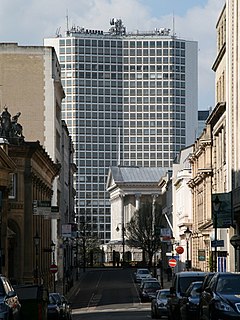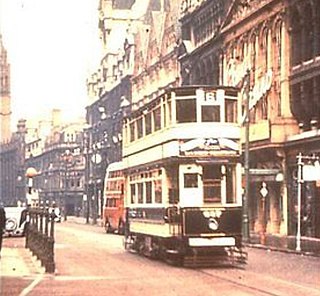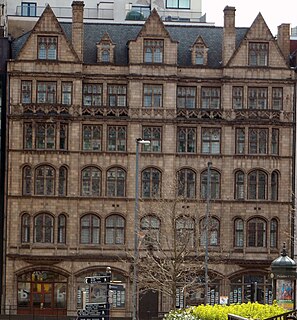
The Hall of Memory is a war memorial in Centenary Square, Birmingham, England, designed by S. N. Cooke and W. N. Twist. Erected 1922–25 by John Barnsley and Son, it commemorates the 12,320 Birmingham citizens who died in World War I.

Sparkhill is an inner-city area of Birmingham, England, situated between Springfield, Hall Green and Sparkbrook.

Although Birmingham in England has existed as a settlement for over a thousand years, today's city is overwhelmingly a product of the 18th, 19th, and 20th centuries, with little surviving from its early history. As it has expanded, it has acquired a variety of architectural styles. Buildings of most modern architectural styles in the United Kingdom are located in Birmingham. In recent years, Birmingham was one of the first cities to exhibit the blobitecture style with the construction of the Selfridges store at the Bullring Shopping Centre.
Emma Frith Bridgwater, known as Emmy Bridgwater, was an English artist and poet associated with the Surrealist movement.

Icknield Street School, near the Hockley Flyover, north of the Jewellery Quarter, Birmingham, England, is a good example of a Birmingham board school. It is owned by Birmingham City Council.

1–7 Constitution Hill in Birmingham, England is a Grade II listed building at the acute junction with Hampton Street, and is a former H.B. Sale factory. The red brick and terracotta structure is extremely thin, with a tower at one end.

The Chamberlain Memorial, also known as the Chamberlain Memorial Fountain, is a monument in Chamberlain Square, Birmingham, England, erected in 1880 to commemorate the public service of Joseph Chamberlain (1836–1914), Birmingham businessman, councillor, mayor, Member of Parliament, and statesman. An inauguration ceremony was held on 20 October 1880, when Chamberlain himself was present.

The Great Western Arcade is a covered Grade II listed Victorian shopping arcade lying between Colmore Row and Temple Row in Birmingham City Centre, England.

Edmund Street is a street located in Birmingham, England.

Birmingham Corporation Tramways operated a network of tramways in Birmingham from 1904 until 1953. It was the largest narrow-gauge tramway network in the UK, and was built to a gauge of 3 ft 6 in. It was the fourth largest tramway network in the UK behind London, Glasgow and Manchester.

Spring Hill Library is a red brick and terracotta Victorian building in Ladywood, Birmingham, England.

Queen's College was a medical school in central Birmingham, England, and a predecessor college of the University of Birmingham. It was founded by surgeon William Sands Cox in 1825 as The Birmingham Medical School, a residential college for medical students. Cox's ambition was for the college to teach arts, law, engineering, architecture and general science. It was the first Birmingham institution to award degrees, through the University of London.
The Birmingham Surrealists were an informal grouping of artists and intellectuals associated with the Surrealist movement in art, based in Birmingham, England from the 1930s to the 1950s.
Robert Melville was an English art critic and journalist. Along with the artists Conroy Maddox and John Melville, he was a key member of the Birmingham Surrealists in the 1930s and 1940s. An early biographer of Picasso, he later become the art correspondent of the New Statesman and the Architectural Review.
Oscar Mellor was an English surrealist artist and publisher of poetry. An associate of the Birmingham Surrealists in the 1940s, he founded the Fantasy Press in the 1950s, publishing works by poets such as Philip Larkin, Kingsley Amis and Thom Gunn.

122–124 Colmore Row is a Grade I listed building on Colmore Row in Birmingham, England. Built as the Eagle Insurance Offices it was later occupied by Orion Insurance and was Hudson's Coffee House until late 2011, It is currently Java Lounge Coffee House.
The Birmingham Artists Committee was an English artist collective that organised exhibitions of painting and sculpture in Birmingham between 1947 and 1952.

Birmingham has a distinctive culture of art and design that emerged in the 1750s, driven by the historic importance of the applied arts to the city's manufacturing economy. While other early industrial towns such as Manchester and Bradford were based on the manufacture of bulk commodities such as cotton and wool, Birmingham's economy from the 18th century onwards was built on the production of finished manufactured goods for European luxury markets. The sale of these products was dependent on high-quality design, and this resulted in the early growth of an extensive infrastructure for the education of artists and designers and for exhibiting their works, and placed Birmingham at the heart of debate about the role of the visual arts in the emerging industrial society.
The Ruskin Galleries was a private art gallery located in what is now Chamberlain Square in Birmingham, England between 1925 and 1940. It provided a venue for the exhibition of modern art at a time when Birmingham's other major artistic institutions were marked by a high degree of artistic conservativism.

Ringway Centre or SBQ is a Grade B locally listed building located on Smallbrook Queensway in the city centre of Birmingham, England. The six-storey, 230 metres (750 ft) long building was designed by architect, James Roberts as part of the Inner Ring Road scheme in the 1950s and is notable for its gentle sweeping curved elevation along Smallbrook Queensway. Completed in 1962 the building originally named the Ringway Centre was the first part of the Inner Ring Road scheme to be completed and the only part with street level shops and footways. The building currently provides office space on its upper floors and commercial space at street level.















